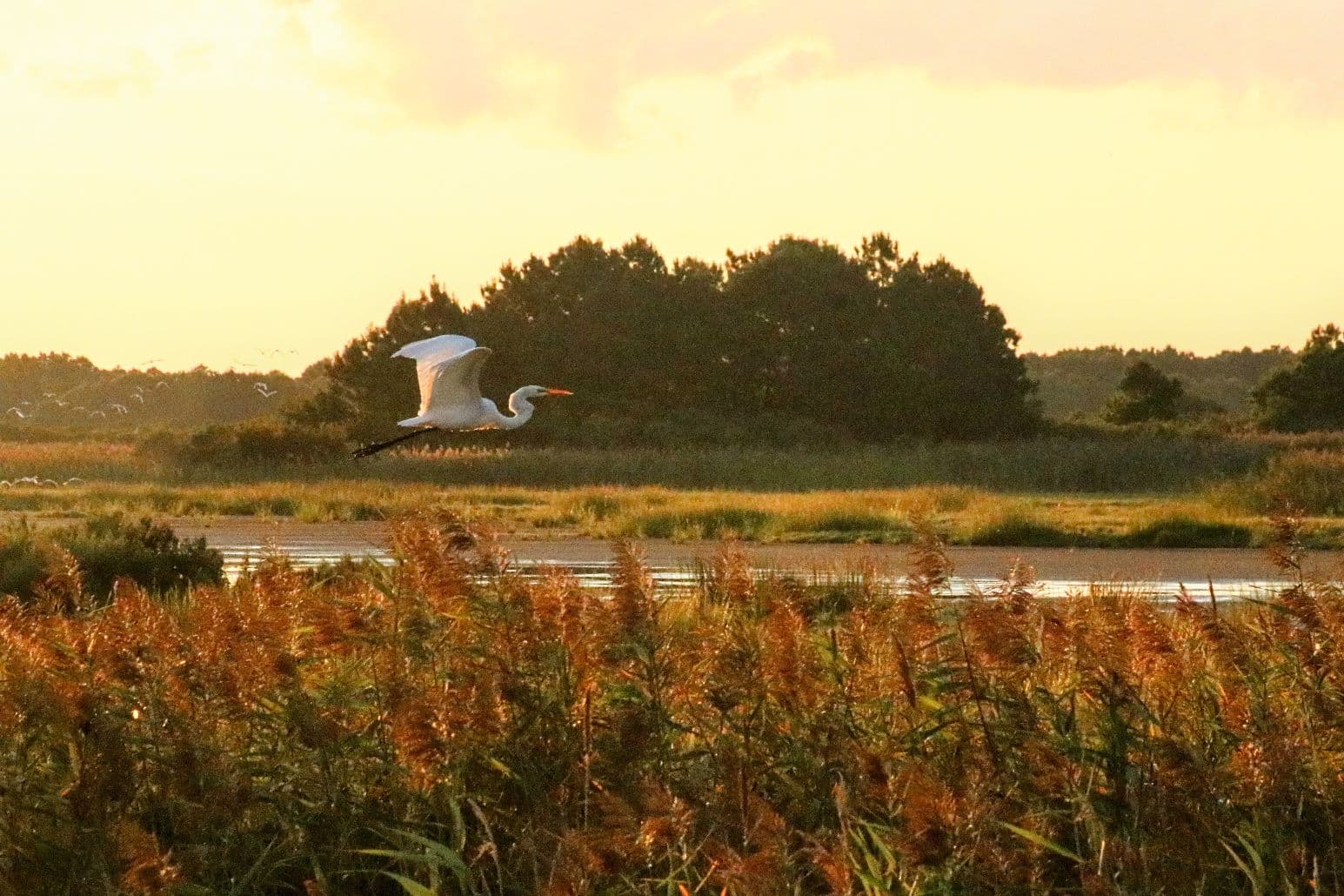In October, Chincoteague National Wildlife Refuge sees a variety of bird species migrating through as part of their fall migration. The Refuge Inn sits at the entrance to the Wildlife Refuge, and sports many great birdwatching opportunities right on the property. CNWR, located on the Atlantic Flyway, is a critical stopover for many migratory birds, particularly waterfowl, shorebirds, and songbirds.
Because October sits at the transition of fall migration, you’ll catch a mix: some late warblers and passerines, continuing raptor traffic, shorebird concentrations still holding, and increasing numbers of waterfowl trickling in. Be sure to read the full article to get Captain Hunter's insider tips for timing a boat tour with the tides to maximize your birding opportunity! Here's a few highlights of the October migration:
Shorebirds
-
Pectoral Sandpipers: A common fall migrant, especially in the mudflats and tidal pools.
-
Dunlins: You can expect to see these small shorebirds in large groups as they pass through.
-
Western Sandpipers: These are often seen during the migration, especially in coastal areas.
-
Killdeer: A shorebird that can be seen foraging in the mudflats or on open ground. Popular on the Wildlife Loop as well.
Songbirds
-
Eastern Towhees: Migrating southward through the refuge.
-
White-throated Sparrows: These sparrows pass through the area, typically in flocks.
-
Ruby-crowned Kinglets: Small, active songbirds that are a common sight in wooded areas during migration.
-
Yellow-rumped Warblers: A common warbler species migrating through in October.
Waterfowl
-
Tundra Swans: Begin arriving in the area as part of their migration southward from northern breeding grounds.
-
Canada Geese: Migrating in large flocks, they often pass through or make stops in the refuge.
-
Ducks: Various species of ducks, including Northern Pintails, Mallards, American Black Ducks, and Green-winged Teals, migrate through in October.
Raptors
-
Sharp-shinned Hawks and Cooper's Hawks: These smaller hawks are migrating through the region, often seen hunting small birds or resting.
-
Northern Harriers: These birds of prey often migrate in large numbers, and you can sometimes spot them gliding over the fields.
Honorable Mentions & Rarities to Keep an Eye On
-
Stilt Sandpiper, White-rumped Sandpiper, Wilson’s Phalarope — occasionally recorded in shallow impoundments or moist-soil units.
-
Hudsonian Godwit, Curlew Sandpiper, Ruff — rare but do turn up in favorable years as vagrants or “fallouts.”
- Bobwhite Quail-- Once plentiful, then rare, now making a comeback. The cutest noises, group dynamics, and behaviors! A favorite on the Wildlife Loop this year.
-
Snow Goose, Ross’s Goose, Greater White-fronted Goose — geese may begin arriving in small numbers.
- Ospreys: While their migration begins earlier, some might still be passing through or lingering along the coast in early October. You can typically see Osprey on a boat tour as they stay mostly on the water.
-
White-faced Ibis, Glossy Ibis — marsh species that sometimes use the refuge’s wet habitats. A great, easy spot to look for these from the car is the marshy area between Lily's Little Mexico and the Village Restaurant.
-
Brown-headed Nuthatch, Pine Warbler — in pine woodland patches and along woodland trails, sometimes right outside pine-side rooms here at the Refuge Inn.
- American Coots: These waterbirds are sometimes seen in ponds or marshes during migration. Fun fact: Unlike ducks, Coots have lobed toes and chicken-like bills. They are actually part of the rail family, even though they are often lumped in with ducks because of their flock behavior.
Chincoteague Birder Pro Tip
We recommend renting the whole boat for a birder tour with Cowboy Cruise Company (call for a cruise timed with the tides) for your best shot at observing shorebirds and waterfowl. They can help you explore the Chincoteague Inlet, the Assateague Hook, and the marshes and mudflats of the Assateague Channel, looking specifically for the birds you specify. Captain Hunter is a William & Mary trained Biologist who spent several seasons at VIMS and also has a lifetime of first-hand experience in the Chincoteague marshes. He is an excellent guide for all things wildlife. Here are his tips for birding tours:
High Tide
-
Best for roosting shorebirds and waders. When mudflats and marsh edges are covered, birds concentrate on higher ground, sand spits, and islands where they’re easier to spot from a boat.
-
You’ll often see herons, egrets, ibis, and oystercatchers gathered together.
-
Raptors such as peregrines and harriers sometimes cruise the channel edges looking for prey pushed into tighter spaces.
Low Tide
-
Best for foraging shorebirds. Exposed mudflats become buffets for sandpipers, plovers, dowitchers, and rarities like Hudsonian Godwits or Curlew Sandpipers if you’re lucky.
-
You’re more likely to see active feeding behavior — probing, running, and chasing small prey in the shallows.
Which Is Better for “Rare Birds”?
-
Low tide generally gives you the best shot at rarities, because many unusual migrants turn up while actively feeding on mudflats.
-
High tide is easier viewing — birds bunch up and are visible at closer range — but it’s usually more common species.
👉 A good tip: time your boat trip for the last two hours of the falling tide into low tide. That way, you see both active feeding and concentrations as the tide shifts.
October is a great time for birdwatching at Chincoteague, as the variety and numbers of migratory birds are quite high. If you’re planning to visit, keep an eye on the skies and wetlands to mark a few new birds off your list.

